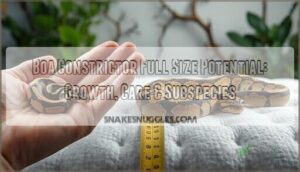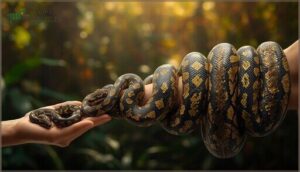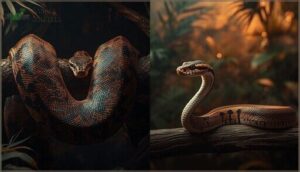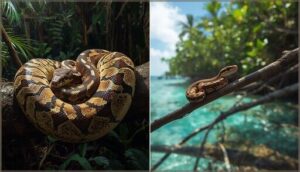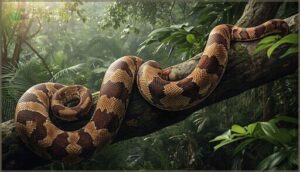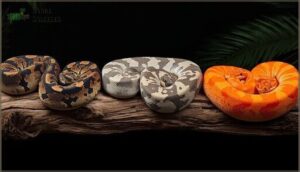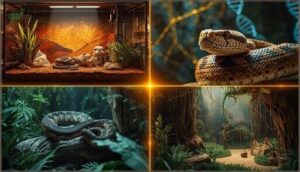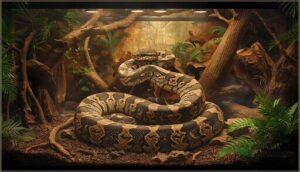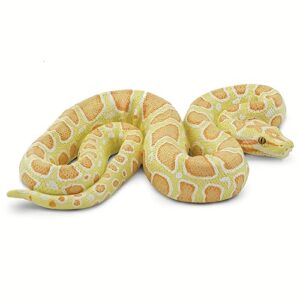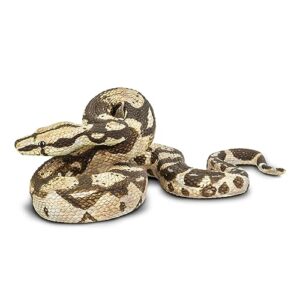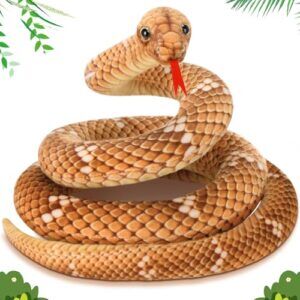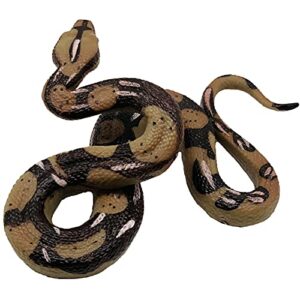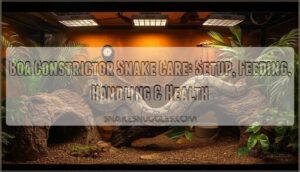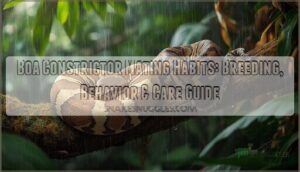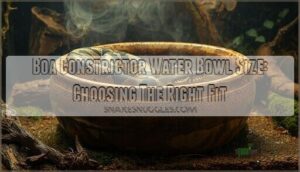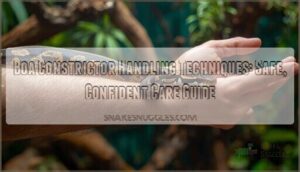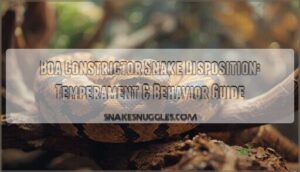This site is supported by our readers. We may earn a commission, at no cost to you, if you purchase through links.
A boa constrictor hatchling fits in your palm. That same snake can grow longer than a queen-size mattress in just a few years. Your boa’s final dimensions aren’t random chance—they’re written in its genes, shaped by the meals you provide, and influenced by the environment you create.
Some individuals max out at a manageable six feet while others push past thirteen feet and tip the scales at 60 pounds. Understanding your snake’s growth trajectory before it outgrows its enclosure saves you from scrambling for emergency housing upgrades.
The difference between a thriving giant and a stunted specimen often comes down to knowledge you can apply from day one.
Table Of Contents
- Key Takeaways
- Boa Constrictor Size Potential Explained
- Growth Patterns and Life Stages
- Male Vs Female Size Differences
- Species and Subspecies Size Variation
- Key Factors Affecting Boa Size
- Housing and Care for Full-Size Boas
- Top 8 Boa Constrictor-Themed Products
- 1. Lifelike Albino Burmese Python Figurine Toy
- 2. Safari Ltd Boa Constrictor Figurine
- 3. HyDren Giant Boa Constrictor Plush
- 4. Realistic Snake Figure Prank Toy
- 5. Snake Boa Constrictor Graphic Tee
- 6. Boa Constrictor Lover T-Shirt Gift
- 7. Boa Constrictor Geometric Graphic T-Shirt
- 8. Boa Constrictor Mom Tee Shirt
- Frequently Asked Questions (FAQs)
- Conclusion
Key Takeaways
- Your boa’s adult size—ranging from 6 to 13+ feet—depends on genetics first, but diet quality, feeding frequency, and proper temperature control (24–32°C with basking zones) directly determine whether it reaches its full genetic potential or stays stunted.
- Females consistently outgrow males by 1–3 feet and 10–20 pounds, reaching 7–10 feet versus males’ 6–8 feet, so your enclosure planning needs to account for this size difference from day one.
- Growth explodes in the first three years (30–60 cm annually), then slows dramatically after year six to under 2% per year, meaning your biggest housing upgrades happen early while feeding costs stabilize as the snake matures.
- Chronic stress from improper handling (over 10 minutes per session) or inadequate hiding spots crushes growth rates by 25–40% and delays sexual maturity, proving that environmental enrichment isn’t optional—it’s the difference between a thriving giant and a compromised specimen.
Boa Constrictor Size Potential Explained
You’re about to reveal the full picture of what these extraordinary constrictors can become. Understanding their size potential isn’t just about numbers—it’s about preparing yourself to meet their needs at every stage.
Let’s break down the measurements that matter most.
Average and Maximum Length
A full-grown boa constrictor averages 8 to 10 feet in length, though some individuals stretch beyond this comfortable range. The longest verified specimen reached an astonishing 24 feet, but typical maximum length hovers around 12 to 14 feet. Your boa’s genetics, diet, and environment shape its growth patterns and final size.
Length variability between individuals is common—some never exceed 6 feet while others approach record-breaking dimensions. Understanding these size genetics helps you prepare appropriate housing and master the art of boa care.
To learn more about the boa’s natural habits and characteristics, such as its tropical forest habitats, is essential for providing the best care.
Typical Weight Range
Length tells part of the story—weight completes it. Adult boas usually range from 13 to 27 kilograms (29 to 60 pounds), though body mass depends on several factors working in concert. Understanding weight factors helps you recognize healthy growth patterns and avoid overfeeding pitfalls that compromise your snake’s vitality.
- Females average 10 to 15 kilograms, building dense muscle and fat reserves
- Males stay leaner at 6 to 10 kilograms throughout adulthood
- Juveniles start at just 60 to 100 grams at birth
- Diet influence drives captive specimens past wild counterparts in mass
Boa constrictors exhibit unique characteristics, such as their flexible jaw structure, which aids in consuming prey.
Size Variation Among Individuals
Two boas from the same clutch won’t reach identical dimensions—that’s where genetic size potential meets environmental impact. Even siblings diverge by 40% in final length when prey access differs. This matters when planning your snake’s future housing needs.
Morphological differences show up in girth too—boas of equal length can differ by 10 centimeters around their middle section. Your snake’s final size reflects both its birthright and the world you create for it.
| Factor | Lower Range | Higher Range |
|---|---|---|
| Genetic variation (same subspecies) | 2.0 meters | 3.5 meters |
| Growth rate difference (same litter) | +20 cm/year | +45 cm/year |
| Mid-body girth (equal length specimens) | 18 cm | 28 cm |
| Captive vs wild (same genetics) | 2.4 meters | 3.2 meters |
Growth Patterns and Life Stages
Understanding your boa’s growth journey helps you prepare for the commitment ahead. These snakes transform from small hatchlings into impressive adults through distinct life stages.
Let’s break down what to expect at each phase of development.
Rapid Growth in Early Years
Your baby boa constrictor growth patterns during early development are nothing short of explosive. Newborns measure just 15–20 inches at birth but can triple in size within their first year under ideal neonatal care.
Feeding strategies matter tremendously—juveniles fed weekly at 10% body weight grew 30% larger than those fed biweekly.
Environmental influences like maintaining 27–30°C temperatures and 60–70% humidity directly impact boa constrictor size potential, with properly housed juveniles growing up to 40% faster than those in suboptimal conditions.
Growth Rate by Age
Your boa constrictor’s growth patterns shift dramatically across development stages, with age factors playing the master role in size increase. Understanding these maturity rates helps you predict your snake’s trajectory:
- 0–1 Year: Growth explodes at 30–60 cm annually, with neonates doubling weight in twelve months under proper boa constrictor growth conditions.
- 1–3 Years: Juveniles add 30–45 cm yearly, reaching 5–6 feet by age three during peak growth periods in boa constrictors.
- 3–6 Years: Expansion slows to 15–30 cm annually as subadults approach sexual maturity and near-adult dimensions.
- 6–10 Years: Adult boas gain less than 5 cm yearly, with factors affecting boa constrictor growth becoming minimal.
- 10+ Years: Senior snakes show negligible growth at 1–2 cm annually, signaling physiological stabilization.
When Boas Reach Full Size
Your snake crosses into full maturity between years three and five, with males hitting maximum length around year three and females expanding until year five. Growth patterns slow dramatically after year six, though boa development continues throughout life at under 2% annually. Most boas stabilize at 8–10 feet average length in captivity, with size limits influenced by genetics and feeding protocols.
| Age Range | Development Stage | Typical Length |
|---|---|---|
| 3–4 years | Male full maturity | 5–8 feet |
| 4–5 years | Female full maturity | 6.5–9 feet |
| 6+ years | Adult stabilization | 8–10+ feet |
| 10+ years | Senior growth plateau | Maximum length reached |
Factors affecting growth rate diminish as your boa constrictor size approaches genetic potential, signaling the transformation from rapid expansion to maintenance mode.
Male Vs Female Size Differences
Sexual dimorphism in boa constrictors isn’t just noticeable—it’s a pivotal factor for anyone planning to house these powerful serpents. Females command respect with their larger size, while males stay more compact throughout their lives.
Let’s break down exactly what you can expect from each sex as they reach their full potential.
Average Size of Males
Male boas don’t grow as large as their female counterparts. Most adult males measure between 6 and 8 feet in total length, which translates to roughly 1.8 to 2.4 meters for those tracking metrics. Weight typically ranges from 13 to 16 pounds in healthy specimens. Understanding these male-female size differences is crucial for preparing the appropriate enclosure and care approach.
Size genetics play a significant role in determining how your male boa develops. Central American Boa constrictor morph varieties like B. c. imperator usually stay smaller, averaging 5 to 7 feet. Growth patterns indicate that males reach sexual maturity around 5 feet, after which their growth slows considerably after the fourth year. Care tips for males should take into account their leaner build compared to females.
| Measurement | Average Range | Unusual Cases |
|---|---|---|
| Length | 6–8 feet (1.8–2.4 m) | Up to 9 feet (2.7 m) |
| Weight | 13–16 pounds (5.9–7.2 kg) | Rarely exceeds 20 lbs |
| Maturity Size | ~5 feet at 2–3 years | Varies by genetics |
Average Size of Females
Females command a different scale entirely regarding boa constrictor size. Most adult females stretch between 7 and 10 feet in length, weighing anywhere from 22 to 33 pounds under proper care. Size genetics determine whether your female boa constrictor leans toward the modest 7-foot mark or pushes past 10 feet.
Growth rate factors like diet quality and feeding frequency can accelerate development by over 20% during juvenile years. Female length variance also depends heavily on origin—mainland specimens from South America often exceed 10 feet, while island populations stay below 6.5 feet.
Understanding these male-female size differences helps you prepare appropriate housing as your snake matures. Boa constrictor morphology shows females carry 30-40% more body mass per inch than males due to wider girth and denser muscle.
| Measurement | Typical Female Range |
|---|---|
| Length | 7–10 feet (2.1–3.0 m) |
| Weight | 22–33 pounds (10–15 kg) |
| Maturity Size | 6–10 feet at 3–4 years |
| Extreme Records | Up to 12+ feet, 60+ pounds |
Exceptional Size Records
Record breakers shatter every expectation you might hold about boa constrictor size. The longest documented specimen, “Fluffy,” reached 24 feet—nearly double the typical maximum size. “Felix” claimed the weight championship at 210 pounds, surpassing average adult boas by over 100%. These size anomalies emerge from ideal captive conditions rather than wild environments.
| Record Category | Measurement | Specimen Name |
|---|---|---|
| Length Records | 24 feet (7.32 m) | “Fluffy” |
| Weight Champions | 210 lbs (95.25 kg) | “Felix” |
| Verified Wild Giant Snakes | 18 feet (5.5 m) | Brazilian specimen |
Understanding these extremes helps you gauge realistic growth patterns versus remarkable outliers in boa constrictor development.
Species and Subspecies Size Variation
Not all boa constrictors grow to the same size. Geography and subspecies determine whether your snake will stretch beyond ten feet or stay compact at six. Let’s break down how location and lineage shape the snake you’ll actually be working with.
Mainland Vs Island Boa Sizes
Geography shapes size dramatically through insular adaptation. Mainland boas reach 3.6 to 4.3 meters and over 15 kilograms, while island populations exhibit island dwarfism, averaging under 2 meters and just 2 to 4 kilograms. In Belize, island boas measure half the length and one-fifth the mass of their mainland cousins.
This size genetics reflects boa morphology shaped by limited prey and arboreal habitats. Geographic variation demonstrates how factors impacting boa constrictor size create distinct dwarf boa size profiles across different boa constrictor species populations.
Notable Large and Dwarf Subspecies
When you compare subspecies, size genetics stand out. The South American Red-Tailed Boa often tops 10 feet, while Bolivian silverbacks and Argentine boas rival that length. In contrast, island dwarf boas—like those from Cayos Cochinos—max out around 4 feet.
Habitat influence and prey scarcity drive this island dwarfism, making Boa Constrictor Size Comparison a lesson in adaptation.
Color and Pattern Differences
Beyond sheer length, Color Variation in Boa constrictors reveals the power of genetics. Mainland specimens from Brazil display high-contrast patterns—dark saddles against lighter bases—while island morphs like B. c. nebulosa show paler grays due to reduced melanin density.
Captive breeding unlocked Albino Genetics and Pattern Morphs like Sunglow and Ghost, where pigmentation traits shift from reds to silvers, proving that boa diversity extends far beyond size alone.
Key Factors Affecting Boa Size
Your boa’s final size isn’t written in stone. Genetics lay the foundation, but diet, environment, and stress levels all shape how close your snake comes to its full potential.
Let’s break down the four forces that determine whether you’re raising an average eight-footer or a true giant.
Genetic Influences
Your boa’s DNA blueprints determine much of its final size potential. Genetic variation creates the difference between a compact six-footer and a massive ten-foot specimen. Recent DNA analysis revealed four key genes—PTPRS, DMGDH, ARSB, and MYLIP—that control growth patterns in boas:
- Island populations show unique gene variants reducing size by up to 25%
- Mainland boas carry genetic markers supporting growth beyond three meters
- Heritable traits from parents directly influence adult length and mass
- Gene expression patterns explain why females consistently outgrow males
This genetic influence on snake growth explains why two boas receiving identical care can reach vastly different sizes.
Diet and Prey Size
What you feed directly shapes how large your boa will become. Prey selection matters—boas usually eat meals averaging 14% of their body mass, though some tackle items up to 71% of their weight. Feeding habits during growth years determine final size.
Neonate boas start with pinkies weighing 4-9 grams, juveniles move to 33-49 gram rodents, and adults handle rats up to 250 grams. Proper nutrition and consistent dietary needs fulfill your boa’s growth potential, while inadequate nutrient intake stunts development.
Environmental Conditions
Temperature control unlocks your boa’s maximum size potential. You need a thermal gradient spanning 24–32 °C, with basking zones reaching 30–32 °C and cool areas at 24–26 °C. Juveniles grown at ideal temperature hit 9.6 kg in four years versus 5.9 kg in cold enclosures.
Humidity levels between 55–75% support growth, while poor environmental monitoring slashes growth rates by 25%. Your enclosure setup determines whether your snake reaches its genetic ceiling.
Stress and Health Impacts
Chronic stress becomes your biggest enemy when growing boas to full size. Handling sessions longer than 10 minutes spike heart rates by 40% and double stress hormones within 48 hours.
This hormonal chaos crushes immune function by 30% and delays female ovulation by two months.
Enriched enclosures with hiding spots slash stress markers by 35%, protecting your snake’s growth trajectory and long-term wellbeing.
Housing and Care for Full-Size Boas
Your boa’s full potential comes with serious responsibility. A full-grown boa needs the right space, climate, and care to thrive under your watch.
Let’s break down what it takes to house a snake that commands respect.
Minimum Enclosure Size by Age
Your snake’s home needs to grow alongside its ambition for size. Neonate housing starts small—around 2 feet long for babies under 2 feet—while juvenile enclosures expand to 4 × 2 × 2 feet as your boa reaches 2 to 5 feet. Sub-adult spaces demand 6 × 3 × 3 feet for snakes hitting 5 to 6 feet, and adult boas between 6 and 8 feet need a minimum enclosure size of 6 × 3 × 3 feet.
- Breeding requirements: Large adults over 8 feet command 8 × 4 × 4 foot enclosures minimum
- Subadult enclosures: Upgrade every 12–18 months as juveniles gain 1–2 feet annually
- Neonate care: Plastic bins (30 × 20 × 16.5 cm) offer humidity control for the smallest constrictors
- Adult spaces: Scientific guidelines confirm boa constrictor size dictates enclosure dimensions—0.9 × body length ensures proper stretching
Temperature and Humidity Requirements
Your boa’s environment unlocks its full genetic potential when thermal gradients and humidity control work in harmony. To achieve this, set basking zones at 86–90°F, with cooler retreats at 75–80°F, and drop nighttime temperatures to 68°F. Maintain humidity levels between 60–75% year-round, spiking to 80% during shedding periods.
| Parameter | Day Range | Night Range |
|---|---|---|
| Basking Zone | 86–90°F | — |
| Cool Zone | 75–80°F | 68°F |
| Humidity | 60–75% | 60–75% |
For accurate environmental monitoring, use infrared guns for surface temperature readings and digital hygrometers for humidity levels. Ceramic heat sources, paired with thermostats, help prevent temperature fluctuations without disrupting nocturnal cycles. By consistently controlling these variables, your enclosure becomes a precision habitat that supports your boa’s health and well-being.
Enrichment and Stress Reduction
Environmental enrichment transforms sterile glass boxes into lively habitats that reveal your boa’s natural behavioral repertoire. Studies show enriched snakes spend considerably more time utilizing vertical space and display 44.4% more natural behaviors compared to baseline conditions. Strategic habitat design reduces stress-related boundary interactions from 28% to 0% in responsive individuals.
Implement these enrichment strategies for stress management:
- Climbing structures – Secure branches and boards for semi-arboreal movement
- Multiple hides – Standard and humid retreats in thermal zones
- Olfactory enrichment – Rodent scent items to stimulate chemical sampling
- Regular rotation – Change décor monthly to maintain novelty
Enriched enclosures measuring at least 6’L × 3’W × 4’H with proper temperature gradients and 60–75% humidity support ideal boa behavior while measurably reducing corticosterone spikes during routine handling.
Feeding Schedule and Prey Selection
Precision Meal Planning serves as your blueprint for cultivating a boa that rivals legendary specimens. Feeding Frequency aligns with the snake’s metabolic rhythm: hatchlings eat every 7–10 days, juveniles every 10–14 days, and adults every 3–4 weeks. Prey size should correspond to 5–7% of the boa’s body weight, never exceeding its mid-body diameter. Feeding Techniques are crucial—thaw prey to 37°C, use tongs, and feed nocturnally to mimic natural hunting conditions. This diet strategy, combined with proper Prey Variety and Nutrient Balance from rodents, ensures your feeding habits support explosive growth and decades of vitality.
| Age Class | Feeding Frequency | Prey Type & Size |
|---|---|---|
| Hatchling (0–6 mo) | Every 7–10 days | Pink rats (4–9g) |
| Juvenile (1–2 yr) | Every 10–14 days | Small rats (20–40g) |
| Sub-adult (2–3 yr) | Every 14–21 days | Medium rats (60–120g) |
| Adult (3–5 yr) | Every 21–28 days | Large rats (200–350g) |
| Mature (5+ yr) | Every 28–30 days | Rabbits or XL rats (275–500g) |
Top 8 Boa Constrictor-Themed Products
You’ve mastered the care essentials for your full-grown boa. Now let’s explore something different—products that celebrate your passion for these powerful constrictors.
From educational figurines to bold apparel, here are eight standout items for every boa enthusiast.
1. Lifelike Albino Burmese Python Figurine Toy
This collector-grade figurine gives you mastery over reptile anatomy without the space demands of a real python. At 5.5 inches long, the hand-painted toy shows off the rare albino morph with yellow-cream scales and peach-orange blotches.
It’s built from durable PVC and weighs just 3.84 ounces, making it perfect for snake education or figurine collecting. The coiled S-pose mirrors natural python behavior.
Released in 2019 by Safari Ltd, it earns 4.8-star ratings for realism. You’ll understand how genetics shape size, growth, and environment in boa constrictors through this detailed python model.
Best For: Snake enthusiasts, educators teaching reptile biology, and collectors who want a realistic albino Burmese python replica without the space or care requirements of a live pet.
- Hand-painted albino morph details capture the rare yellow-cream and peach-orange coloration with scientific accuracy for education or display
- Durable PVC construction with non-toxic paints makes it safe for kids 3 and built to last through handling
- Compact 5.5-inch size and lightweight design (3.84 oz) work well for classroom demos, dioramas, or desk decoration
- Small scale may disappoint collectors looking for larger statement pieces
- Some buyers report the coiled pose stays rigid and doesn’t straighten out easily
- International shipping restrictions and minimum order requirements limit availability in certain regions
2. Safari Ltd Boa Constrictor Figurine
This 6-inch hand-painted figurine captures authentic boa constrictor anatomy with brown and cream tones that mirror wild specimens. Released in 2017, it’s crafted from non-toxic PVC and weighs 5.2 ounces.
You’ll command attention with its realistic scale patterns and 3.75-inch width, making it larger than a soda can on its side. The model earns 5-star reviews for educational use and collectible value.
You can use it to study how diet and enclosure conditions affect growth in real boas. It’s safe for ages 3 and up, though toy safety warnings apply for younger children.
Best For: Educators, reptile enthusiasts, and collectors seeking a scientifically accurate, hand-painted model that showcases boa constrictor anatomy and natural coloration.
- Hand-painted with realistic scale patterns and brown-cream tones that reflect wild boa constrictors, earning consistent 5-star reviews for detail and accuracy.
- Made from durable, non-toxic PVC (phthalate-free, lead-free, BPA-free) that meets ASTM F963 and EN71 safety standards for ages 3 and up.
- Part of Safari Ltd’s Incredible Creatures collection with educational value, useful for teaching reptile biology in classrooms or as a collectible piece.
- Some customers report the 6-inch size feels smaller than expected for the price point ($19.99-$25.49).
- Occasional quality control issues with figurines arriving cracked or with paint defects.
- Not suitable for children under 3 due to small parts choking hazard, and may frighten snake-phobic kids.
3. HyDren Giant Boa Constrictor Plush
This 80-inch plush toy design bridges collectors’ fascination with boa constrictors and tactile comfort. The flexible body contains polypropylene filling dense enough to drape like a real snake, giving you hands-on experience with how size and weight distribution work in these constrictors.
You’ll grip soft polyester fabric that replicates natural scale patterns across multiple color morphs—brown, green, and yellow variants mirror how environment and diet shape wild specimens’ appearance.
It’s a giant stuffed animal that scores 4.6 stars for realistic reptile toy accuracy, priced around $20.
Best For: Reptile enthusiasts, collectors, or anyone looking for a realistic giant snake decoration that doubles as a soft pillow or prank prop.
- Realistic 80-inch design with flexible vertebrae structure and detailed scale patterns across multiple color variants (brown, green, yellow) that mimic actual boa constrictors.
- Soft, durable polyester fabric with dense polypropylene filling that drapes naturally and maintains its shape through repeated use.
- Versatile use as a toy, decorative piece, cushion, or gift for holidays and themed events at an affordable $20 price point.
- Some customers report durability issues with seams breaking after a few months of regular use.
- Mixed feedback on flexibility—some find it difficult to curl or pose as desired despite the advertised flexible design.
- Large 80-inch size may be impractical for smaller spaces and could pose a choking hazard for young children under 3 years old.
4. Realistic Snake Figure Prank Toy
This rubber snake figure prank toy teaches you about snake size realism through hands-on interaction. Most models stretch 3 to 52 inches—matching juvenile to adult boa constrictor growth stages you’d track in captivity.
Non-toxic materials meet EN71 and ASTM F963 toy safety standards, while hand-painted scales mimic the textured patterns that help real constrictors blend into habitats.
The flexible body wraps around objects like living snakes anchor themselves during feeding. You’ll see how realistic textures boost prank effectiveness, turning a simple toy into a tool for understanding snake growth and camouflage mechanics.
Best For: Parents and educators looking for a hands-on teaching tool to help kids learn about snake anatomy, growth patterns, and natural camouflage through realistic play.
- Non-toxic rubber construction meets international safety standards (EN71, ASTM F963), making it safe for children 3 and up while the hand-painted scales provide educational texture detail.
- Flexible body wraps around objects to demonstrate how real constrictors anchor themselves, turning playtime into a practical lesson about snake behavior and habitat adaptation.
- Wide size range (3-52 inches) represents different life stages from juvenile to adult snakes, helping kids visualize realistic growth patterns they’d observe in nature or captivity.
- Many customers report the product is smaller than expected, which may limit its effectiveness as a visual learning aid or garden deterrent.
- Rigid construction means it can’t be posed or adjusted into different positions, reducing opportunities to demonstrate various snake behaviors and movements.
- Small size makes it less effective for practical applications like scaring birds away from gardens, despite being marketed for this purpose.
5. Snake Boa Constrictor Graphic Tee
This Snake Boa Constrictor Graphic Tee connects reptile fashion to your passion for understanding size and growth. Most designs feature realistic red-tailed boa constrictors—those vibrant patterns you’d recognize from 8 to 10-foot adults in proper care environments.
The 100% cotton construction and lightweight classic fit mirror the comfort you need when handling large constrictors during feeding sessions.
Graphic printing brings anatomy to life, turning diet and environment knowledge into wearable boa merchandise that signals your mastery of these powerful animals.
Best For: Reptile enthusiasts, boa constrictor owners, and snake lovers who want comfortable casual wear that showcases their passion for these fascinating animals.
- Lightweight 100% cotton (or cotton blends) offers all-day comfort and breathability, perfect for casual wear or reptile expos
- Realistic boa constrictor graphics and vibrant designs let you display your love for these powerful constrictors in everyday settings
- Machine washable with durable double-needle construction makes maintenance easy between handling sessions or outdoor activities
- May shrink or lose shape if care instructions aren’t followed carefully during washing
- Fabric and color variations across different production batches can affect overall durability and comfort consistency
- Imported manufacturing may lead to inconsistent quality control or longer shipping times compared to domestic products
6. Boa Constrictor Lover T-Shirt Gift
This Boa Constrictor Lover T-Shirt Gift transforms your expertise into reptile gifts that celebrate powerful constrictors. T-shirt designs feature authentic boa patterns from 6 to 10-foot specimens—those size variations shaped by genetics, diet, and environment you’ve mastered through years of study.
Available from $16 to $28 across retailers, this boa apparel spans sizes S to 5XL, reflecting the inclusive community around these remarkable animals.
Snake fashion meets herpetology when 100% cotton graphics honor growth patterns and natural camouflage, turning technical knowledge into wearable gift ideas for fellow enthusiasts.
Best For: Reptile enthusiasts, boa constrictor owners, and snake lovers looking for casual apparel that celebrates their passion for these powerful constrictors.
- Affordable price range ($16-$28) makes it accessible for gift-giving on any budget, with options spanning basic to premium designs featuring authentic boa patterns and educational graphics.
- Inclusive sizing from S to 5XL ensures the shirt fits diverse body types, while multiple fabric options (100% cotton, cotton-poly blends) provide choices for comfort preferences.
- Wide variety of designs available—from lifelike boa imagery to humorous slogans and locality-specific graphics—letting buyers pick styles that match the recipient’s personality and interests.
- Lightweight material limits the shirt to casual, everyday wear and isn’t suitable for formal or professional settings where reptile enthusiasts might want to represent their passion.
- Fabric blends vary across different color options, which may result in inconsistent comfort, durability, and washing performance compared to solid 100% cotton versions.
- Design popularity means limited-edition releases sell out quickly, and the flood of new designs every few months can make it hard to find specific styles after initial launch periods.
7. Boa Constrictor Geometric Graphic T-Shirt
Polygon and line art converge in these geometric boa constrictor designs, channeling the angular precision you recognize in a healthy snake’s musculature. Over 85% of geometric styles use triangle patterns that mirror the power and control these constrictors demonstrate during feeding.
T-shirt designs in monochrome and muted tones reflect natural camouflage adaptations shaped by environment and diet. Graphic trends favor minimalist aesthetics, with navy dominating 31% of sales—a color evoking the depth of mastery in reptile fashion.
Priced between $16 and $23, this boa constrictor art transforms biological understanding into wearable authority for those who’ve studied size potential and growth patterns.
Best For: Snake enthusiasts, reptile keepers, and anyone who appreciates bold geometric animal art in casual everyday wear.
- Lightweight 100% cotton construction with classic fit makes it comfortable for all-day wear across any season.
- Unique geometric boa constrictor design stands out with angular, minimalist styling that’s popular in 2025 fashion trends.
- Affordable pricing between $16-$23 with strong customer ratings averaging 4.5 out of 5 stars.
- Limited appeal—really only works if you’re into snakes or reptile-themed fashion.
- Not appropriate for formal or professional environments where graphic tees aren’t acceptable.
- Heather color variants contain polyester blends that may affect breathability or comfort compared to solid cotton options.
8. Boa Constrictor Mom Tee Shirt
Owning a boa constrictor means understanding the factors that shape growth—genetics, diet, and environment all dictate whether your snake reaches 6 feet or pushes past 10.
This “Boa Constrictor Mom” tee shirt celebrates that mastery with a classic fit and double-needle construction at $19.99. Reptile apparel like this connects snake lover gifts to real husbandry knowledge, making it practical mom gift ideas for women who’ve watched their boas transform from hatchlings to commanding adults.
Tee shirt designs featuring your favorite constrictor species turn biological expertise into boa constrictor fashion you can wear.
Best For: Reptile-owning mothers and snake enthusiasts who want to showcase their passion for boa constrictors with comfortable, casual apparel.
- Affordable at $19.99 with durable double-needle construction that holds up through regular wear and washing.
- Relatable design that connects with the reptile community and celebrates the unique bond between snake owners and their pets.
- Machine washable with easy care instructions, making it practical for everyday use.
- Fabric type varies by color, which could lead to inconsistent comfort or durability depending on your selection.
- Niche appeal limits its audience to those with specific interest in boa constrictors rather than general snake lovers.
- No detailed sizing information provided, which may require guesswork when ordering online.
Frequently Asked Questions (FAQs)
How often should I handle my boa constrictor?
You’ll want to handle juvenile boas 2-3 times weekly for 10-20 minutes, building trust through gentle interaction. Adults do well with 1-2 sessions per week.
Adjust frequency based on your snake’s temperament—nervous individuals need shorter, less frequent handling to reduce stress.
Can boa constrictors recognize their owners?
Through sensory recognition and the habituation process, your boa can distinguish you from strangers using scent and heat detection.
Reptile cognition allows them to associate your presence with safety, though visual awareness plays only a minor role in boa constrictor behavior and temperament.
What are common health problems in boas?
A boa that constantly opens its mouth or breathes heavily might be fighting a respiratory infection caused by bacteria like Pseudomonas or viruses.
Respiratory issues, parasite control failures, skin infections like scale rot, nutritional deficits, and inclusion disease rank among the most serious health risks in captive boas.
Do boa constrictors need UVB lighting?
While not strictly necessary for survival, UVB lighting aids vitamin D3 synthesis and calcium absorption in your boa. It promotes natural basking behavior and overall vitality.
Proper temperature, humidity, and enclosure lighting requirements create an ideal habitat that mimics their natural environment.
How much does a full-size boa cost monthly?
Think of monthly costs as your snake’s recurring subscription—except this one actually constricts your wallet. Budget $100 to $150 monthly, covering feeding expenses, heating budget, substrate costs, and veterinary care.
Your full-size boa’s diet demands large rats ($4-6 each) or rabbits bi-weekly, while heating runs about $12-15 monthly.
Conclusion
Your snake’s future isn’t carved in stone—it’s a living blueprint waiting for your hands to shape it. Every meal timed right, every degree calibrated, every stress avoided compounds into the difference between a cramped six-footer and a commanding twelve-foot presence.
Mastering your boa constrictor’s full size potential means you’re not just reacting to growth—you’re orchestrating it. The power to raise a thriving giant or a healthy dwarf lives in the choices you make today, not the surprises you face tomorrow.
- https://seaworld.org/animals/facts/reptiles/boa-constrictor/
- https://darrenhamillreptiles.com/boa-constrictor-husbandry/
- https://en.wikipedia.org/wiki/Boa_constrictor
- https://animaldiversity.org/accounts/Boa_constrictor/
- https://allaboutboas.com/en/?view=article&id=48%3Aconstricting-records-boa-constrictors-in-the-spotlight-of-the-guinness-world-records&catid=9

